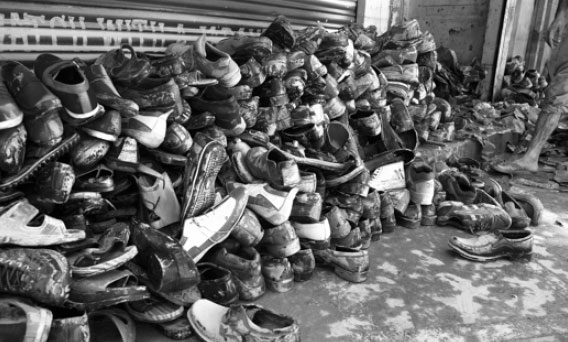Disasters hit more people than conflicts
Norwegian experts pin blame on poor planning, global urbanization
Natural disasters displaced three times more people last year than violent conflicts, showing the urgent need to support vulnerable people, according to a study released on Wednesday.
The Norwegian Refugee Council, an independent group that focuses on emergency aid, released the findings ahead of a United Nations summit on Tuesday aimed at building momentum for a global agreement addressing climate change.
|
A Kashmiri shopkeeper stacks water-damaged shoes on the street outside his flood-affected shop in Srinagar on Wednesday. The main city in India-controlled Kashmir has "drowned completely" under floodwaters, an official said. Dibyangshu Sarkar / Agence France-Presse |
The council's head added that the report did not find that man-made climate change was the main culprit in the displacements but laid blame on urbanization and bad planning.
The report said that 22 million people were displaced in 2013 as a result of disasters brought on by natural hazards, nearly three times the number who were forced from their homes because of violent conflict.
The problem has been worsening, with roughly twice as many people displaced around the world by disasters now than in the 1970s, even as better forecasting and relief operations have reduced the number of deaths.
"It's a wake-up call, I think, to world leaders coming here. As bad as it is today, it will be dramatically worse unless much more is invested in resilience," said Jan Egeland, the council's secretary-general.
"We have to make people in the Philippines or Chad or in Haiti as resilient as we are in Norway or in many parts of the United States," he said.
Egeland is the former UN emergency relief coordinator who played a high-profile role drumming up international support after the 2004 tsunami in the Indian Ocean.
He cited that experience as a model, saying that the more than $13 billion that poured in after the tsunami went not only for reconstruction but also built up resilience for future disasters.
Such an effort needs to happen on a global scale.
"We need to get people out of this vicious cycle of being vulnerable and therefore being hit very hard again," he said.
Upcoming summit
UN Secretary-General Ban Ki-moon called Tuesday's summit to mobilize world leaders before the 2015 conference in Paris that is meant to draft a new global agreement on climate change.
The Norwegian study pointed to findings of a UN-led scientific panel, the Intergovernmental Panel on Climate Change, which has said that human activity is contributing to the greater frequency and intensity of disasters around the planet.
The report said that a sharp rise in urbanization, and bad planning, were the primary factors in explaining the steep rise in disaster displacement.
"We are not saying here that it's climate change that has explained the increase. It's just as much, or more, population growth and urbanization, bad planning and more exposure to the elements," Egeland said.
More than 80 percent of the people displaced by natural disasters last year were in Asia, the report found. The Philippines suffered the two most disruptive disasters last year, with typhoons Haiyan - also known as Yolanda - and Trami together displacing 5.8 million people.
(China Daily 09/18/2014 page11)















